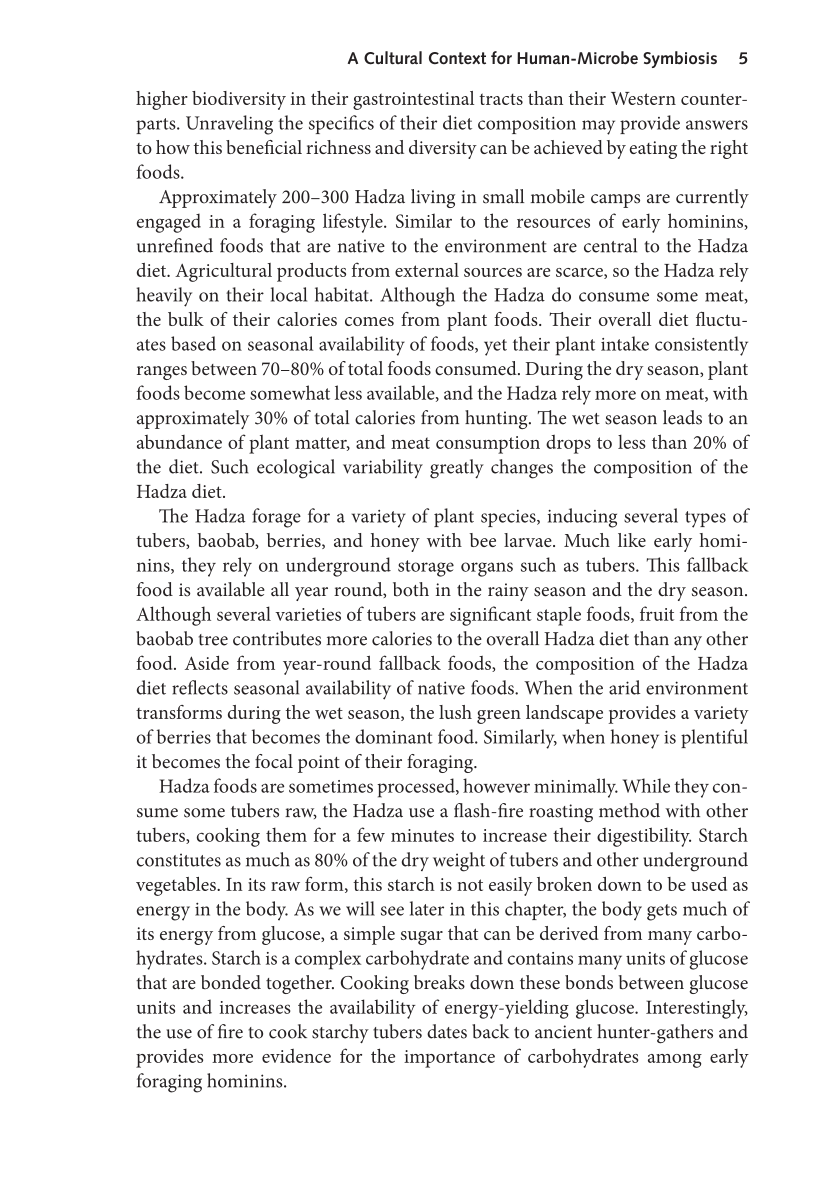A Cultural Context for Human-Microbe Symbiosis 5
higher biodiversity in their gastrointestinal tracts than their Western counter-
parts. Unraveling the specifics of their diet composition may provide answers
to how this beneficial richness and diversity can be achieved by eating the right
foods.
Approximately 200–300 Hadza living in small mobile camps are currently
engaged in a foraging lifestyle. Similar to the resources of early hominins,
unrefined foods that are native to the environment are central to the Hadza
diet. Agricultural products from external sources are scarce, so the Hadza rely
heavily on their local habitat. Although the Hadza do consume some meat,
the bulk of their calories comes from plant foods. Their overall diet fluctu-
ates based on seasonal availability of foods, yet their plant intake consistently
ranges between 70–80% of total foods consumed. During the dry season, plant
foods become somewhat less available, and the Hadza rely more on meat, with
approximately 30% of total calories from hunting. The wet season leads to an
abundance of plant matter, and meat consumption drops to less than 20% of
the diet. Such ecological variability greatly changes the composition of the
Hadza diet.
The Hadza forage for a variety of plant species, inducing several types of
tubers, baobab, berries, and honey with bee larvae. Much like early homi-
nins, they rely on underground storage organs such as tubers. This fallback
food is available all year round, both in the rainy season and the dry season.
Although several varieties of tubers are significant staple foods, fruit from the
baobab tree contributes more calories to the overall Hadza diet than any other
food. Aside from year-round fallback foods, the composition of the Hadza
diet reflects seasonal availability of native foods. When the arid environment
transforms during the wet season, the lush green landscape provides a variety
of berries that becomes the dominant food. Similarly, when honey is plentiful
it becomes the focal point of their foraging.
Hadza foods are sometimes processed, however minimally. While they con-
sume some tubers raw, the Hadza use a flash-fire roasting method with other
tubers, cooking them for a few minutes to increase their digestibility. Starch
constitutes as much as 80% of the dry weight of tubers and other underground
vegetables. In its raw form, this starch is not easily broken down to be used as
energy in the body. As we will see later in this chapter, the body gets much of
its energy from glucose, a simple sugar that can be derived from many carbo-
hydrates. Starch is a complex carbohydrate and contains many units of glucose
that are bonded together. Cooking breaks down these bonds between glucose
units and increases the availability of energy-yielding glucose. Interestingly,
the use of fire to cook starchy tubers dates back to ancient hunter-gathers and
provides more evidence for the importance of carbohydrates among early
foraging hominins.
higher biodiversity in their gastrointestinal tracts than their Western counter-
parts. Unraveling the specifics of their diet composition may provide answers
to how this beneficial richness and diversity can be achieved by eating the right
foods.
Approximately 200–300 Hadza living in small mobile camps are currently
engaged in a foraging lifestyle. Similar to the resources of early hominins,
unrefined foods that are native to the environment are central to the Hadza
diet. Agricultural products from external sources are scarce, so the Hadza rely
heavily on their local habitat. Although the Hadza do consume some meat,
the bulk of their calories comes from plant foods. Their overall diet fluctu-
ates based on seasonal availability of foods, yet their plant intake consistently
ranges between 70–80% of total foods consumed. During the dry season, plant
foods become somewhat less available, and the Hadza rely more on meat, with
approximately 30% of total calories from hunting. The wet season leads to an
abundance of plant matter, and meat consumption drops to less than 20% of
the diet. Such ecological variability greatly changes the composition of the
Hadza diet.
The Hadza forage for a variety of plant species, inducing several types of
tubers, baobab, berries, and honey with bee larvae. Much like early homi-
nins, they rely on underground storage organs such as tubers. This fallback
food is available all year round, both in the rainy season and the dry season.
Although several varieties of tubers are significant staple foods, fruit from the
baobab tree contributes more calories to the overall Hadza diet than any other
food. Aside from year-round fallback foods, the composition of the Hadza
diet reflects seasonal availability of native foods. When the arid environment
transforms during the wet season, the lush green landscape provides a variety
of berries that becomes the dominant food. Similarly, when honey is plentiful
it becomes the focal point of their foraging.
Hadza foods are sometimes processed, however minimally. While they con-
sume some tubers raw, the Hadza use a flash-fire roasting method with other
tubers, cooking them for a few minutes to increase their digestibility. Starch
constitutes as much as 80% of the dry weight of tubers and other underground
vegetables. In its raw form, this starch is not easily broken down to be used as
energy in the body. As we will see later in this chapter, the body gets much of
its energy from glucose, a simple sugar that can be derived from many carbo-
hydrates. Starch is a complex carbohydrate and contains many units of glucose
that are bonded together. Cooking breaks down these bonds between glucose
units and increases the availability of energy-yielding glucose. Interestingly,
the use of fire to cook starchy tubers dates back to ancient hunter-gathers and
provides more evidence for the importance of carbohydrates among early
foraging hominins.























































































































































































































